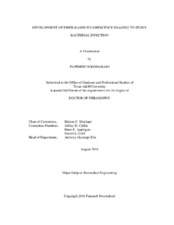| dc.description.abstract | Tuberculosis (TB) is a deadly pulmonary disease with an especially high mortality rate in immuno-compromised populations, specifically children and HIV positive individuals. The causative agent, Mycobacterium tuberculosis (Mtb), is very slow growing—making both diagnosis and development of effective treatments very difficult. Whole-animal fluorescence imaging with recombinant or fluorescently-tagged pathogens or cells enables real time analysis of disease progression and treatment response in live animals. However, tissue absorption limits penetration of fluorescence excitation light, particularly in the visible wavelength range, resulting in reduced sensitivity to deep targets. In this dissertation, the use of an optical fiber bundle to deliver light into the mouse lung to excite fluorescent bacteria was shown to circumvent tissue absorption of excitation light in a whole-animal imaging system. A fiber-optic fluorescence microendoscope was integrated into a whole-body imaging system for in-vivo Mtb detection.
First, we employed this technology to improve detection of recombinant reporter strains of tdTomato-expressing Mycobacterium bovis BCG (Bacillus Calmette Guerin) bacteria in the mouse lung. Using this technique, the threshold of detection was measured as 10^3 colony forming units (CFU) during pulmonary infection. In comparison, the threshold of detection for whole-animal fluorescence imaging using standard epi-illumination was greater than 10^6 CFU.
We next exploited an endogenous enzyme of Mtb (β-lactamase, or BlaC) using a BlaC-specific NIR fluorogenic substrate. In the presence of BlaC, this substrate is cleaved and becomes fluorescent. Using intravital illumination of the lung with the fiber microendoscope to excite this probe, the sensitivity of the optical system increases over trans-illumination and epi-illumination methods of whole-body fluorescence imaging. We demonstrated that the integration of these optical imaging technologies with a BlaC-specific fluorescent reporter probe increases the system sensitivity by two orders of magnitude, allowing detection down to ~100 colony forming unit (CFU) infection. This lower detection threshold enables the study of early stage bacterial infection and could allow for longitudinal studies of disease pathogenesis and therapeutic efficacy with multiple time points measured in a single animal. | en |


